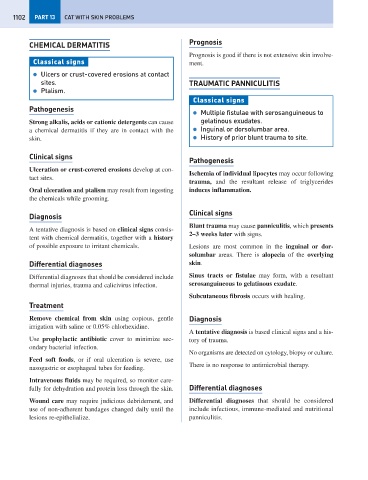Page 1110 - Problem-Based Feline Medicine
P. 1110
1102 PART 13 CAT WITH SKIN PROBLEMS
CHEMICAL DERMATITIS Prognosis
Prognosis is good if there is not extensive skin involve-
Classical signs ment.
● Ulcers or crust-covered erosions at contact
sites. TRAUMATIC PANNICULITIS
● Ptalism.
Classical signs
Pathogenesis
● Multiple fistulae with serosanguineous to
Strong alkalis, acids or cationic detergents can cause gelatinous exudates.
a chemical dermatitis if they are in contact with the ● Inguinal or dorsolumbar area.
skin. ● History of prior blunt trauma to site.
Clinical signs
Pathogenesis
Ulceration or crust-covered erosions develop at con-
Ischemia of individual lipocytes may occur following
tact sites.
trauma, and the resultant release of triglycerides
Oral ulceration and ptalism may result from ingesting induces inflammation.
the chemicals while grooming.
Clinical signs
Diagnosis
Blunt trauma may cause panniculitis, which presents
A tentative diagnosis is based on clinical signs consis-
2–3 weeks later with signs.
tent with chemical dermatitis, together with a history
of possible exposure to irritant chemicals. Lesions are most common in the inguinal or dor-
solumbar areas. There is alopecia of the overlying
Differential diagnoses skin.
Differential diagnoses that should be considered include Sinus tracts or fistulae may form, with a resultant
thermal injuries, trauma and calicivirus infection. serosanguineous to gelatinous exudate.
Subcutaneous fibrosis occurs with healing.
Treatment
Remove chemical from skin using copious, gentle Diagnosis
irrigation with saline or 0.05% chlorhexidine.
A tentative diagnosis is based clinical signs and a his-
Use prophylactic antibiotic cover to minimize sec- tory of trauma.
ondary bacterial infection.
No organisms are detected on cytology, biopsy or culture.
Feed soft foods, or if oral ulceration is severe, use
There is no response to antimicrobial therapy.
nasogastric or esophageal tubes for feeding.
Intravenous fluids may be required, so monitor care-
fully for dehydration and protein loss through the skin. Differential diagnoses
Wound care may require judicious debridement, and Differential diagnoses that should be considered
use of non-adherent bandages changed daily until the include infectious, immune-mediated and nutritional
lesions re-epithelialize. panniculitis.

